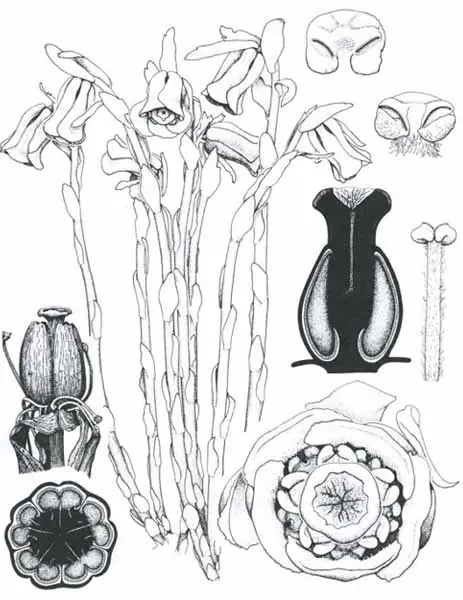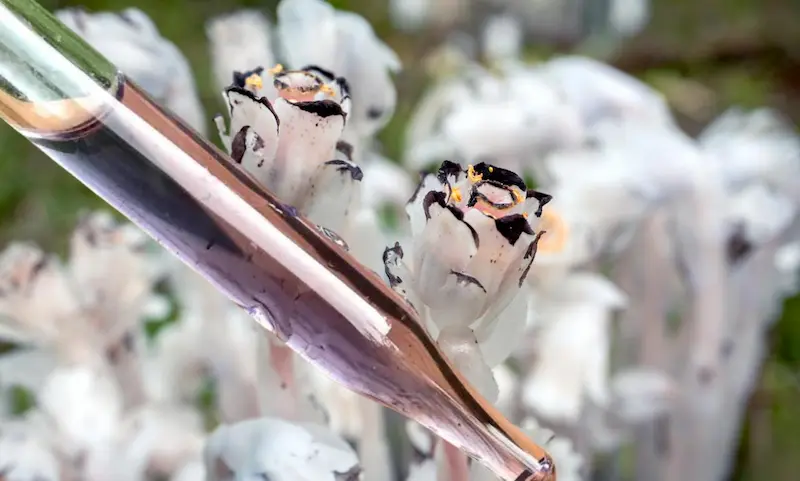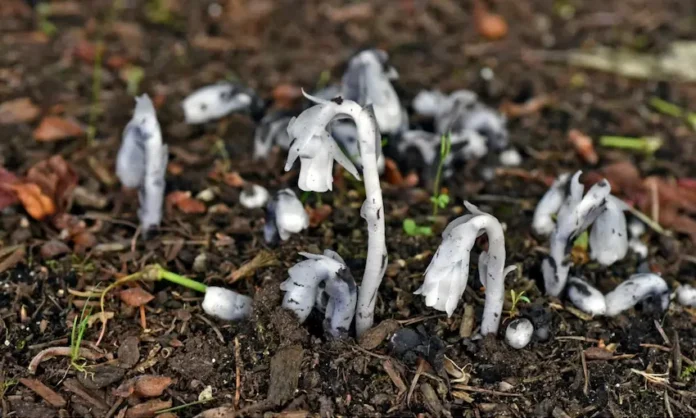Ghost pipe (Monotropa uniflora), also known as the Indian pipe, is a perennial herbaceous plant within the heather family (Ericaceae). Originating from Asia, it thrives in cold, shady forests, emerging in dark, damp areas rich with diverse fungi, resembling a shadow.
Its stems, ranging from 5 to 30 centimeters in height, feature tiny leaves approximately 5 to 10 millimeters long, resembling scales. These structures, small, slender, and translucent, lack stalks, emerging as sheaths from the stem. Its appearance spans from early summer to early autumn, coinciding with warm, humid weather and recent rainfall.
The ghost pipe presents an almost ethereal sight, boasting elegant, bell-shaped white flowers crowning its apex. Each flower emerges at the stem’s pinnacle, evoking an ornamental candle in the dim landscape. While modestly dormant during the day, at night, its flowers emit a delicate, somewhat sweet fragrance that entices curious forest visitors.

Taxonomy
| Kingdom: | Plantae |
| Order: | Ericales |
| Family: | Ericaceae |
| Genus: | Monotropa |
| Species: | Monotropa uniflora |
Other names: Indian pipe, ghost plant
Blooming period
| I | II | III | IV | V | VI |
| VII | VIII | IX | X | XI | XII |
What Does it Contain Ghost Pipe?
The ghost pipe isn’t a plant that contains the usual chlorophyll found in most plants, utilizing photosynthesis to create sustenance.
Instead, it relies on fungi, forming a symbiotic relationship to acquire nutrients. Furthermore, it contains some organic compounds and chemicals, yet its composition and biological activity remain inadequately explored. Limited research and its distinctive ecological dietary method have led to a lack of widespread documentation or extensive knowledge about the specific compounds or detailed composition within this plant.
Where Does Ghost Pipe Grow?
The ghost pipe is a healing herb that typically thrives in forested areas of the northern hemisphere. It flourishes in shaded, damp forests, often nestled under the canopy of trees, particularly birches or conifers. People commonly harvest this plant during the summer months, usually from July to September, when the Monotropa uniflora flowers reach full development.
While the seeds of the ghost pipe are easily accessible, cultivating it indoors or with human intervention remains unfeasible. Gardeners seek methods for its cultivation, yet its reproduction mechanism remains elusive and unidentified.
Ghost Pipe Health Benefits
The ghost pipe stands out for its numerous medicinal properties. Its sedative, antispasmodic, and diaphoretic effects prove beneficial in managing neurological disorders like psychosis, acute anxiety, restlessness, irritability, agitation, and convulsion episodes. When combined with rosewater, ghost pipe sap demonstrates remarkable efficacy in treating ulcers, gonorrhea, bladder inflammation, and ophthalmic inflammations are just some of the ghost pipe benefits.
This rich plant contains salicylic acid as a key component that promotes analgesia. Salicylic acid functions akin to Aspirin, providing relief from various pains, including migraines, emotional distress, and intense physical discomfort. Moreover, the ghost pipe aids in suppressing traumatic memories that might induce anxiety and panic attacks due to sensory overload.
Indian Pipe Medicinal Uses
Due to its eerie appearance and the multitude of spiritual associations, the ghost pipe has earned this peculiar name. However eerie its name may sound, the Indian pipe holds numerous medicinal benefits that can be utilized for healing purposes.
Freshly harvested above-ground parts of the Indian pipe, along with their medicinal properties, are used exclusively when fresh. They cannot be stored, even after drying, as this process might darken the petals. Preserving them within a tincture is the only way to maintain their medicinal benefits.
How to make a Ghost pipe tincture?
Once you’ve gathered several above-ground parts of the ghost pipe, place three or four lightly rinsed stems with flowers into a half-liter glass jar. Pour 2 to 3 ounces of 100-proof vodka over the mixture, ensuring all flower parts are fully covered; add extra if needed. Using scissors, chop the flowers/stems while submerging in the vodka. Seal the jar and let it sit for about 4 weeks. The tincture will acquire a lovely shade of purple.
The shelf life of this tincture is typically 2 to 3 years. It’s normal for it to gradually lose its purple hue over time, but at that point, it’s still suitable for use.

How to use Indian pipe tincture?
As is customary with tinctures, the initial dosage typically ranges around 3 drops. Individuals with a smaller body constitution or lower weight might find that one drop is sufficient. Place 1 to 3 drops in a cup, add a little water and consume.
Refrain from using it before driving, operating machinery, or venturing outside the home, as it may induce drowsiness. Its calming and relaxing effects usually take around 20 minutes to manifest post-consumption. Use it at your discretion as individual reactions vary, given that the tincture is a potent remedy and hasn’t been extensively studied by modern researchers.
What is Ghost Pipe Tincture used for?
Those enduring severe pain or anxiety attacks typically use ghost pipe tincture in small doses.
Ghost pipe tincture benefits is aids in managing neurological conditions, especially psychosis, nervousness, irritability, anxiety, and even convulsions. Ghost herbs is ideal for addressing mental and emotional distress that can sometimes escalate to psychosis. Its optimal calming property not only assists with nerve-related conditions but also significantly alleviates intense nerve pain.
For everyday common aches, the Indian pipe tincture isn’t necessary. Moreover, it’s not recommended for pregnant women, nursing mothers, or children.
